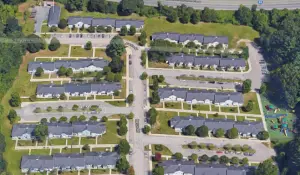Wellesley continues to mull future of its public housing properties
Wellesley is trying to figure out how best to modernize its public housing stock in a way that will improve life for existing residents, open opportunities to additional people, and make better use of its property. Any such effort would sync up with the town’s broad Unified Plan as well as its more specific Housing Production Plan.
The Wellesley Housing Authority (WHA) has been reviewing a feasibility study focused on the Barton Road development since it was was presented in mid-February by consultant Tise Design Associates of Newton. The original idea was to explore the possibility of redeveloping the Barton Road family-focused properties into a consolidated development housing seniors, too (though seniors would also remain in housing behind the police station along Washington Street, conveniently located near the senior center).

WHA’s Maura Renzella said the intention of any such redevelopment plan would be to gain capital from the Barton Road complex, which currently stands on what she described as a “ridiculously small” portion of that 18-acre parcel. Such capital, against a backdrop of limited outside funding resources, could be used in part to redevelop the subsidized housing units on Washington Street. While the report—labeled as a “recapitalization study” on slides shown at the May 12 meeting of the Community Preservation Committee (see Wellesley Media recording)—does explore options for Barton Road, it doesn’t really answer questions about opportunities at Washington Street, she said.
Renzella gave a heads up to the Community Preservation Committee (CPC), which funded the Barton Road study, that the WHA would likely be back before Special Town Meeting in the fall to ask for money to conduct a new study focused on the town’s Washington Street and neighboring Morton Circle public housing properties, which are older and more in need of revamping than the Barton Road development. The Morton Circle properties were built in 1959 and haven’t undergone any major facelifts since and the Washington Street properties have been around since the 1970s, whereas the Barton Road development was built in 1950 but renovated in 2001.
Rethinking Barton Road
One possibility in redeveloping the Barton Road property outlined in the study would be to use 40R zoning, as is being employed at the development at Wellesley Office Park, to allow up to 320 units on the site and provide financial benefits to the town. WHA currently has 88 units at Barton Road, and 235 units across all its properties.
Another zoning option, recommended in the report, would divvy the Barton Road property into two parcels under a residential incentive overlay district, which could pave the way for 20,000 sq. ft. of retail and more than 700 apartment units, including a 4-story “senior village.” The report also explained how such an option could be funded, over four phases of development. While public housing units would hold steady on their rent calculations based on area median income, other units might be handled differently under this scenario. But daunting for WHA board member Kim Maire was the millions in gap funding that would need to be realized beyond grants, bank loans, and such.
There’s a trend among housing authorities to sign on well-heeled private developers for such projects in light of limited resources being available from state agencies.
Between wrapping up the TISE study, considering a new study on Washington Street and Morton Circle, and figuring out how the state might help, all involved acknowledged the complexity of the situation. The WHA is also in talks with the Planning Department, which has long been interested in the topic of reimagining the Cedar Street corridor that includes the Barton Road area as well as office parks closer to Rte. 16.
“Any housing conversation in town for any site is so much more complicated than it appears at face value,” lamented CPC Chair Barbara McMahon, who vowed that the Committee would do anything it could to help sort things out.
Whether the fates of the Barton Road and Washington/Morton developments will be dealt with separately or not remains to be seen, but it appears likely they’ll be linked in some way. Whatever happens, change is probably years off. “In the housing world,” Renzella said, “if we start talking about the project now, we’re talking 10-20 years” until a project gets done.